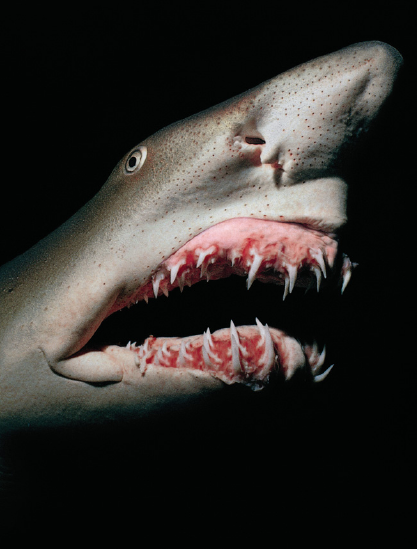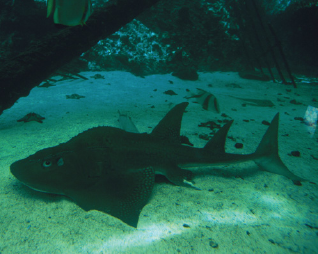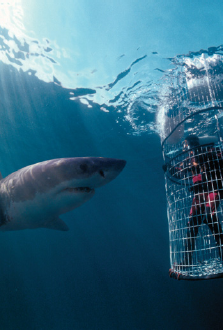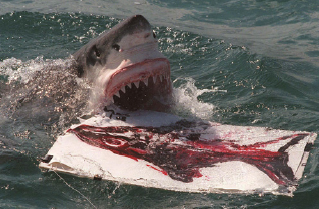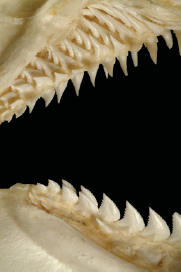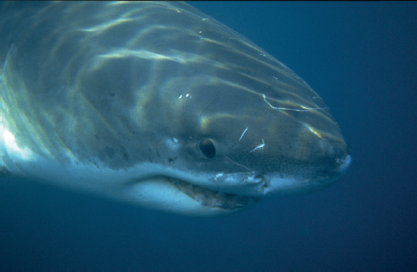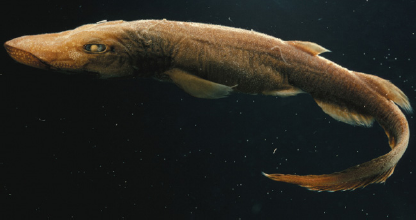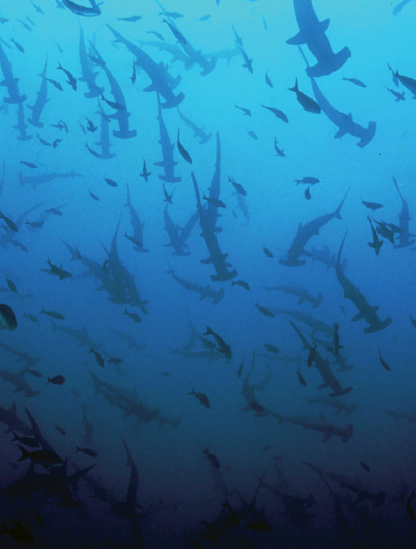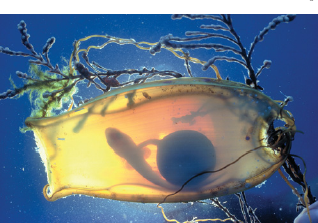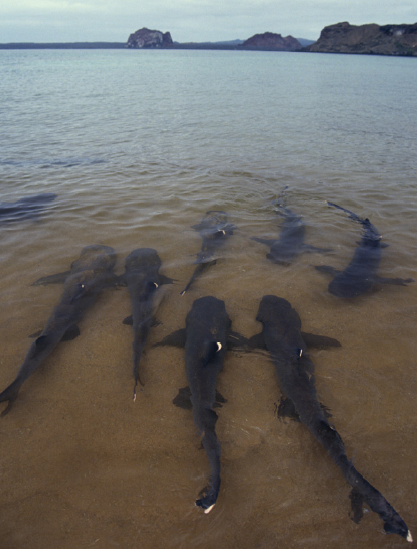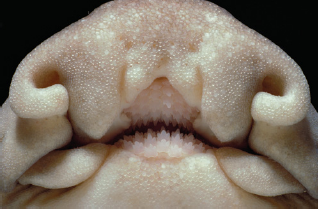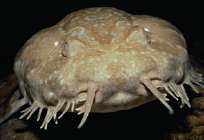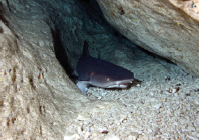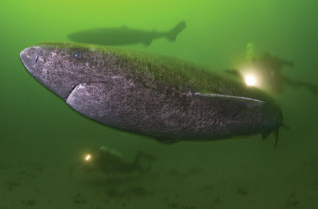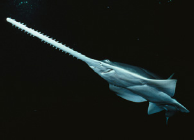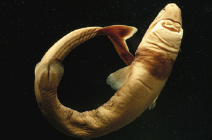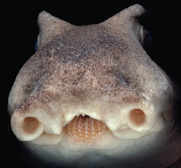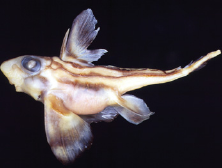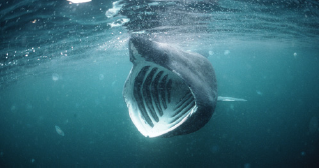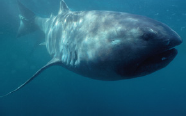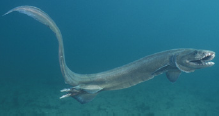Sand tiger shark (Carcharias taurus) at night off North Carolina.
1 A Timeless Design
Compared to a time-tested design such as the shark, Homo sapiens is a recent prototype. Geneticists estimate the age of our own subspecies at a mere 200,000 years, whereas Mother Nature has been mass-producing sharks since well before the Jurassic age, more than 130 million years ago. Fossils of the common six-gill shark, of the order Hexanchiformes, have been dated to the Permian period, more than 225 million years ago. Canadian palaeontologists recently discovered in New Brunswick a full fossil of a 409-million-year-old Diliodus problematicus.1 Sharks predate the dinosaurs, not to mention mammoths, mastodons, sabretooths and thousands of other species that nature discontinued. Humans may be one of the most numerous species on earth, our numbers exceeded only by certain insects and bacteria, but we’re not diversified. For all our heights and hues, we are only one species. All our eggs are in one basket, named Homo sapiens, which leaves us completely vulnerable to a universal agent, a disease or toxin or some other metaphorical dropping of the basket.
Sharks, on the other hand, enjoy a bounteous diversity. Beside the four truly dangerous sharks, the great whites, tiger sharks, bull sharks and oceanic whitetips – those most often conjured in hysterical news stories, sensational films and our nightmares – there exist such unlikely-looking creatures as the goblin shark (Mitsukurina owstoni) which sports a pike above its mouth; the thresher sharks (phylum Alopias), whose scythe-like tails account for 50 per cent of their total length; the megamouth shark (Megachasma pelagios), discovered in 1976 when one attempted to eat the sea anchor of a warship; the sawfish shark (of which there exist nine distinct species), whose snout looks like a chainsaw; the bonnet and hammerhead sharks which look like cartoons of a shark whose head has been flattened in a vice; and the ingenious little cookie-cutter shark (Isistius brasiliensis) which dashes in, latches on to a much larger prey, and corkscrews out a circular bite. When it comes to the shark, nature is nothing if not inventive. The swell shark (Cephaloscyllium ventriosum) inflates itself to several times its normal size by sucking in water, both as a defence and as a way to expand its mouth, which it then holds open like a Venus fly-trap, waiting for an unsuspecting fish to swim in. The bull shark (Carcharhinas leucas), a less amusing species, can adapt to either fresh or salt water and has been caught as far up the Mississippi as Illinois, 1,750 miles from the sea. Even more unexpectedly, in May 2007 a bull shark was caught in the Neva River, at St Petersburg in Russia, which is not only fresh water but thousands of miles from their nearest warm-water habitat.
Shark ray, better called bowmouth guitarfish (Rhina anclyostoma), Queensland, Australia. |
|
|
The swell shark (Cephalosyllium ventriosum) swallows water to inflate itself to a larger size, not only to compensate for its harmless appearance, but also to wedge itself in crevices. |
Known by many local names, including Lake Nicaragua shark, Van Rooyen’s shark and Zambezi shark, the bull shark is often considered to be the most aggressive species. (In fact, it may contain the highest percentage of the aggression-related hormone, testosterone, of any animal.) Bull sharks prefer the murky and muddy water close to shore. They haunt the mouths of rivers throughout Indonesia, the Caribbean Basin, the Gulf of Mexico and the Indian Ocean. They follow the canals into residential areas of eastern Australia and Florida. They infest the Amazon, swimming upstream more than 2,300 miles. Many scientists have speculated that the infamous Matawan Shark of 1916, model for the ‘rogue shark’ in Jaws, was in fact two or three sharks, at least one of which must have been a bull since it travelled two miles up New Jersey’s brackish Matawan Creek to a muddy freshwater pool, where it killed two swimmers and maimed a third. These sharks can be amazingly tenacious, sometimes refusing to relinquish their victims even after being dragged on to the beach. In the case of the attack on Jessie Arbogast, who was bitten repeatedly in 60 centimetres of water while fishing off a sandbar on the Gulf Coast of Florida in 2001, both boy and bull shark had to be pulled ashore together. Jessie was bleeding profusely with the two-metre shark clamped to his leg. Only when the shark had been shot with a rifle could the animal’s jaws be prised open, and rescuers were able to recover Jessie’s severed arm from its throat.
Fishy business: a bull shark caught near St Petersburg, Russia.
Chuck Anderson, a high-school athletic director from Alabama, was training for a triathlon when he was attacked just offshore by a 2.5-metre bull shark. The shark bit him on the leg, the hand, the stomach and just kept coming back. Finally it held on, dragging him across the bottom towards the beach. Anderson dragged himself out of the water with the shark clamped down on his arm. Only by yanking, ‘degloving’ his forearm of skin and muscle and losing his hand, was Anderson able to free himself.2
Appalling as such incidents may be, the bull shark also represents an amazing adaptive achievement, being able to adjust the urea content in its blood to maintain a balance in the osmosis process within its kidneys. Other, very isolated freshwater sharks exist – the Bizant River shark (Glyphis sp. A) and the Northern River shark (Glyphis sp. B) that live in freshwater rivers in northern Australia – and other fish species such as eels and salmon pass from fresh to salt water at different stages of their life cycles. But what makes the bull shark so singular is its ability to make the biological switch routinely. Bull sharks routinely swim from the Pacific Ocean up the San Juan River to Lake Nicaragua, where they attack people, pets and livestock. Once believed to be a separate, landlocked species, the Lake Nicaragua shark has recently been observed commuting up and down the seventeen-mile river, negotiating the rapids along the way.
Scuba diver in South African style shark cage, viewing Great White sharks, Dyer Island, South Africa. |
|
In the south-eastern US and along the Gulf Coast, bull sharks are sometimes referred to as ‘gentlemen in grey suits’. Unremarkable in colour with short, blunt snouts, they are typical Carcharhinid sharks, usually distinguished by their stockiness, their small eyes and their lack of such beauty marks as black fin tips. So what is there to recommend them? The easy answer is their use to us. Any living creature with such a highly responsive kidney function is a marvel of biological engineering, worth having if only for the possibility of later imitation. Beyond the selfish, anthropocentric issue of the bull shark’s possible utility to us, however, lies the question of its place within a larger system. In the bull shark, nature has created an elegant adaptive design for which the future may hold a purpose beyond anything we can currently imagine.
|
Great White shark at Dyer Island off Cape Town with Olly and Suzi’s painting Shark Bite, 1997. |
The dominant ocean predator, at least among fishes, is Carcharodon carcharias – the great white shark. As long as 6.7 metres and weighing more than 180 kg, white sharks are simply huge, often a metre and a half wide at the beam. When encountered underwater in poor visibility, the shark’s tail and head are not visible at the same time. Monstrous as white sharks may appear, however, they’re only scale models of their ancestors, Carcharodon megalodon, which ruled the seas during the middle and late Cenozoic period, roughly 50 million years ago. Megalodons, meaning ‘great tooth’, have been estimated from their fossilized feet and jaws to have been sixteen metres in length and to have tipped the scales at eighteen tonnes, about ten times the weight of great white sharks. They are believed to have survived into the latest Pleistocene or even our Holocene period, which is the last 10,000 years, meaning that prehistoric humans may have seen megalodons.3 We can imagine how the terror of sighting a two-metre dorsal fin might send shock waves down through our hereditary DNA. The cause of the megalodon’s extinction is unknown. Beside the obvious predatory benefits of being the biggest, fiercest fish in the sea, mass helps to conserve heat, making it easier for the largest ocean creatures to maintain their body temperatures above the level of the surrounding water and thereby enjoy the advantages of quicker muscular reactions. There is no evidence to suggest a lack of food for megalodons. Their preferred meal was whales, of which there were no known insufficiencies until the twentieth century. Their disappearance is thus a mystery, one reason why sensationalist writers and filmmakers imagine them still living in the Mariana Trench, near Guam.
White sharks also enjoy feeding on whales, but only the dead or infirm ones who can’t defend themselves. Without apparent regard for their cholesterol levels, they eat great chunks of whale blubber, first below the water line, then above, hurling themselves out of the water to seize and tear out a ten-kg mouthful before flopping back in. Fat tissue can be metabolized into heat much faster than muscle, and the lamnids or mackerel sharks (makos, porbeagles, salmon sharks and great whites) maintain body temperatures at least three to five degrees Celsius above the temperature of the water. Warmer muscle and nerve cells react faster to stimuli, adding to the advantages of surprise. The white shark’s typical modus operandi is to cruise the bottom, nine to fifteen metres below the surface, scanning for the silhouette of a seal or sea lion, then hurtling upwards in an open-maw rush to deliver a disabling initial wound. White sharks don’t look for a fair fight. They prefer to lurk nearby while their victims expire, then feed at leisure.
|
Sharks’ teeth are designed to work in tandem, lowers for holding and uppers for cutting. |
The great white shark is admirably adapted to its tasks of hunting, killing and feeding. Its jaws are famously immense and powerful, exerting almost a tonne of pressure per square centimetre and housing up to four full rows of granite-hard teeth. (Sharks’ teeth, set in gum tissue rather than a jaw bone, rarely fracture, but they do break off, so it’s shrewd of nature to keep multiple rows in reserve.) While the white shark’s narrower lower teeth spike the prey and hold it in place, its triangular upper teeth with their sharp serrations can saw through both flesh and bone rapidly and efficiently. White sharks are also able to project their teeth by pulling back the fleshy tissue around their mouths – think of this fleshy part as their lips – and lifting their long snouts. This technique is particularly useful when biting into larger prey, the flanks of whales or the midsections of massive elephant seals. Sharks also have the sensitivity to evaluate the consistency and the taste of the meat in their mouths. First, their gums sense degrees of softness and hardness. Second, their tongues can taste not only blood but also fat. White sharks will often spit out their prey if the taste, firmness, or mouth-feel suggests that killing and consuming it are not worth the effort. The good news is that humans, apparently, are too lean and bony to be desirable. The bad news is that the initial, exploratory bite of a white shark can be fatal.
White shark at the Farallon Islands, California, 2001.
If we can ignore their rare but devastating attacks upon us, we see that great white sharks are beautifully engineered from tip to tail. Their snouts are conical, like aeroplanes, and for similar design reasons. Their tails are enormous, with equal-sized lobes (like those of tuna), also designed for bursts of speed. White sharks may not be zippy by the standards of makos or dolphins, but fifteen mph is more than sufficient for an ambush. Their pointed nose cones contain nostrils, powerful olfactory sense organs capable of detecting minute amounts of blood in the water, perhaps as little as one part per 10 billion.4 Also located at the tip of the white shark’s snout are electrical sensors, jelly-filled pores that look like black stubble. These sensors, called ampullae of Lorenzini, detect the electrical energy created by movements as small as the flutter of a fin or a heartbeat. Awkward or erratic movements such as the thrashing of an injured animal can be detected even more accurately, allowing the shark to zero in on potential prey.
The popular myth is that sharks are merely eating machines, violent and dumb. While such primitive sharks as dogfish do have tiny brains, others such as white sharks possess surprisingly large ones. One difference between us and them is that the shark’s brain is not clumped into a sphere but stretched out longitudinally as a series of connected lobes. Another difference is the way the shark’s mental resources are allocated. As we would expect, smell sensitivities comprise a relatively huge percentage of the shark’s total capacity; what may be surprising is the size of its optic lobe, located at the centre of everything. Unlike bull sharks, which are nearly blind, white sharks have keen eyesight; hence their preference for hunting in the daytime. Another significant portion of the shark’s brain is devoted to the reception and analysis of impulses from the ampullae of Lorenzini and the lateral line system, a network of nerves and water-filled tubes along their sides that sense pressure waves and low-frequency vibrations, such as those created by a fish – or swimmers – in distress.
Besides helping to locate prey, the ampullae of Lorenzini can, according to some scientists, enable sharks to navigate by orientating themselves by the earth’s magnetic field.5 The ampullae were first discovered to be sensitive to electrical stimuli by University of Birmingham zoologist R.W. Murray in the 1950s.6 Two University of Utrecht scientists, S. Dijkgraaf and A.J. Kalmijn extended Murray’s work to the lateral line.7 In 2005, by means of satellite tags, white sharks were tracked from the Farallon Islands all the way to Hawaii, more than 2,000 miles. These tagged sharks followed the current south towards Baja California, then turned west, heading directly for the Hawaiian Islands where they spent the winter, heading directly back to California in the spring. Scot Anderson and Peter Pyle tracked one shark (nicknamed ‘Tipfin’) making the same journey two years in a row.8 Until fairly recently, sailors found it easy to miss islands thousands of miles out in the Pacific. That a shark can navigate so reliably in spite of currents and the lack of landmarks suggests highly sophisticated sensory gear.
Deep-sea cat shark, also known as longnose cat shark (Apristurus kampae), Galapagos, Isla San Salvador. Note the electrical field receptors on the shark’s snout.
Other sharks also migrate. Blue sharks from North America make the Atlantic crossing twice a year, preferring to give birth off the coast of Ireland. Great hammerheads (Sphyrna mokarran) annually congregate in their thousands, like conventioneers, in the Sea of Cortez and off the coast of Costa Rica. Since these sharks have hardly changed since the Jurassic period, their astonishingly accurate navigational abilities must pre-date ours by many millions of years. Might we find something to learn from them? It seems possible.
Hammerhead sharks off the Cocos Islands, Costa Rica, 1994.
Our earliest studies of sharks were recorded by Aristotle who, among other occupations, was an excellent naturalist. Since sharks are rarely observed in the act of reproducing, Aristotle’s description of their copulation is particularly admired. Although he probably did not witness the act himself, he accurately records that ‘cartilaginous fishes lie down side to side and copulate belly to belly’.9 Aristotle also distinguished between males and females on the basis of the males’ dual appendages, which came to be called ‘claspers’ because of their shape – although, as Aristotle made clear, they didn’t clasp at all.
|
Nor, as it turns out, are male sharks essential to reproduction. Parthenogenesis, or ‘virgin births’, instances of an egg or embryo developing without any genetic contribution from a male, have been attributed to both hammerheads,10 black-tip reef sharks and bonnetheads, the more recent occurring in a Nebraska aquarium where a shark captured more than three years earlier gave birth.11 Beyond the laboratory or an isolated aquarium, we can scarcely imagine a place where a female shark cannot find a mate, but this surprising ability in sharks does suggest that ‘primitive’ systems may enjoy survival talents that we have yet to discover.
Whitetip reef sharks (Triaenodon obesus), come to shallow water to mate, Galapagos Islands, Ecuador.
Quite apart from their potential usefulness to us, a great many shark species have achieved levels of adaptive brilliance, if not perfection. Blue sharks (Prionace glauca) are among the most beautiful creatures on earth – not only for their colour, a deeply satisfying cerulean, but also for their sinuous ease of movement. With their wide eyes, blue sharks appear permanently curious, as indeed they are, to the extreme discomfiture of shipwrecked sailors. Another curious species even more feared by survivors of shipwrecks and downed aircraft is the oceanic whitetip (Carcharhinus longimanus). Oceanic whitetip sharks are believed to have the keenest ability to sense sound (whether they hear it or feel its vibrations is less certain), congregating at the scene of a wreck from as far as 80 miles away. The much-dreaded tiger shark (Galeocerdo cuvier) is the world’s champion omnivore, known to consume not only fish, turtles, albatrosses and surfers but also metal cans, number plates and, in one famous instance in the eighteenth century, an entire suit of armour. Hammerhead and bonnet sharks operate like electronic spy planes. These sharks have such highly developed electrical sensors in the ampullae of Lorenzini dotting their stretched-out heads that they specialize in hunting skates and rays buried under a layer of sand. The sharks sense the tiny voltage given off by their hidden prey, then hover over the spot, whisking away the sand with their tails and fins to flush out their next meal. When we consider that so many shark species have remained unchanged for 50 million years or more, it seems logical to conclude that they’re at or near their ideal state of evolution, supremely adapted to their tasks.
The skin of sharks is another brilliant innovation – if a design feature from the Jurassic period can be considered an ‘innovation’. Unlike fish scales, sharkskin actually consists of denticles, like teeth, that reduce turbulence and thus improve swimming efficiency. Dermal denticles also make for a far tougher hide than any other protective surface. Rubbed from front to back, sharkskin feels smooth, the better to swim with. When brushed from back to front, however, these denticles will rub our own skin raw – the better to discourage contact.
|
Nostrils and mouth and teeth of crested horn shark or crested bullhead shark (Heterodontus galeatus) at night, South Australia, Great Australian Bight. |
Even more crucial to the shark’s successful design is its cartilaginous skeleton. Sharks have no bones in their bodies but possess a softer, lighter frame made of cartilage. The purpose of this is buoyancy. Typically, bone has twice the specific gravity of water: it therefore sinks. Shark cartilage, however, is only slightly denser than water, making it far easier to balance with lighter-than-water organs such as the liver. A shark’s liver is immense – sometimes as large as 25 per cent of the animal’s total weight – since its purpose is not merely to filter blood but to act like an internal balloon. The liver contains light tissue and fluids. At least one species of shark has been found to retain air for buoyancy. The sand tiger shark (Carcharias taurus) rises to the surface to swallow air, which it then holds in its stomach, enabling it to hang motionless in the water.
All sharks are slightly negative in buoyancy. Unless they swim, or develop the clever technique of swallowing air, they sink. Consequently, sharks are equipped with thicker, more powerful fins to provide lift. Sharks’ pectoral fins are huge relative to those of other fish, extending like wings or long paddles. The pectoral fins of the oceanic whitetip are so long that its Latin name, Carcharias longimanus, refers to its ‘long arms’, its pectoral fins wide as wings. Although the market for sharks’ immense, sturdy fins may well be a contributing factor to their demise, we can still appreciate these hydro-nautical appendages for reasons beyond their use as a base for a gelatinous soup. Pectoral fins give steering and lift. The caudal and dorsal fins on the top and the anal fin on the bottom provide stability, helping to prevent yawing and rolling. All propulsion comes from the tail, but here sharks vary widely. At one extreme are the speedy lamnid sharks – white sharks, porbeagles, salmon sharks and (speediest of all) the two species of makos – all with pointed noses and tails of equally proportioned lobes. At the other extreme are the slower species, including long-distance swimmers like blue sharks and the languid leopard sharks with tails of very different-sized lobes to accommodate their leisurely swimming pace. Oceanic whitetips appear particularly effortless as they make their sinuous approach.
While many larger species of shark must always keep moving along, using their body’s propulsion to push water into their gills, enabling them to breathe by a process known as ram ventilation, other species are able to hang motionless or even rest on the bottom. Lemon sharks and bull sharks, for instance, can pump water over their gills by opening and shutting their mouths, allowing them to lie still on the bottom, whether for ambush, relaxation or sleep. Some species – particularly the angel shark and wobbegong (not surprisingly, an Australian Aborigine name) – have the same ability as the skate and stingray to partially bury themselves in the sand and use their unusually strong throat and gill muscles to pump water over their gills.
More surprising is the discovery that prowling sharks, as opposed to lurkers, also indulge in apparent naps. In 1969 a free-diver named Ramon Bravo found a cave full of snoozing sharks near Isla Mujeres, off the Yucatan. His observations were confirmed by the famous ‘shark lady’, marine biologist Eugenie Clark. Clark identified the species as the non-sedentary Caribbean reef shark (Carcharias perezi). She also discovered that the particular caves in which the sharks liked to doze contained water with high oxygen and low salinity, perhaps due to upwellings of fresh water from the onshore aquifer. Since motionlessness is so rare in Caribbean reef sharks, Clark speculated that the high oxygenation made respiration easier and might be producing a narcotic effect. Subsequent research teams have observed three and possibly four species besides the Caribbean reef shark in the Isla Mujeres caves: the lemon shark (Negaprion brevirostris), the blue shark (Prionace glauca), the tiger shark (Galeocerdo cuvier) and possibly the bull shark.12 The presence of such true pelagics (ocean-going fish) as blue and tiger sharks seems particularly surprising.
Wobbegong shark (Orectolobus maculatus) head-on, Australia.
A sleepy whitetip shark rests deep in an underwater cave.
|
Whether sharks sleep remains a mystery, and one that depends on how we define ‘sleep’. Although the Isla Mujeres sharks were dubbed ‘sleeping sharks’, divers reported that the sharks in the caves were always watching, their eyes following the divers. But then, so might the eyes of inebriates, or frequenters of an opium den. Were the sharks conscious? Is eye tracking an automatic response in sharks? Do any sharks ‘sleep’ as we understand the term? Without hooking them up to electroencephalographs, we can never be sure. Nor is Eugenie Clark’s theory about oxygen narcosis supported by the evidence of other species, in other places, quietly respiring. In scattered locations across the Pacific and off Cocos Island of Costa Rica, whitetip reef sharks (Triaenodon obesus) have been discovered in caves stacked up like somnolent logs, but none of these caves enjoy highly oxygenated water similar to those at Isla Mujeres. So what could they be doing in that cave? Cuddling perhaps, or bonding? We are so lacking in research data about shark behaviour and physiognomy that we can only speculate, basing our conclusions on little more than our own mammal models. Do sharks socialize? Do they need a little shut-eye to feel on top form? Such questions call attention to the limits of our own conceptual frames.
Speaking of sleeping sharks, those called ‘sleepers’ don’t. Once believed to be sluggish bottom dwellers, all eighteen species of sleeper sharks of the Somniosidae family are actually stealth predators. Entirely black with equal-sized dorsal fins and floppy caudal fins, sleeper sharks move very slowly so as to remain undetected. Pacific sleeper sharks (Somniosus pacificus) of the Bering Strait and Chukchi Sea prefer to swim vertically, up and down the water column, presumably to surprise their prey. Pacific sleepers grow to be seven metres long; Greenland sharks (Sominus microcephalus), their first cousins, to six metres. It’s unclear whether these huge sharks would be a danger to humans since so few of us bathe in their waters. Still, whale, walrus and seal meat have been discovered in their stomachs. The long-distance swimmer Lynn Cox was quite worried about Pacific sleepers when she made her historic swim between Little Diomede Island, belonging to the US, and Big Diomede Island, then part of the USSR, in 1987.13 Whereas polar bears can be spotted quite easily as white spots paddling across a black sea, Pacific sleeper sharks are black things that rise from below.
Such sneakiness is also the secret of success for the cookie-cutter sharks (Isistius brasiliensis, Isistius labialis and Isistius plutodus). Like their cousins the sleeper sharks, cookie-cutters have equal-sized dorsal fins and floppy tails. They’re not built for speed but for stealth. Cookie-cutter sharks are rarely more than a third of a metre in length but they specialize in much larger prey. They approach the prey undetected before, as we have already seen, cork-screwing out a mouth-shaped bite. Many cookie-cutters are heterodontal, meaning that they have entirely different-shaped teeth on the top and bottom of the mouth. The top teeth are hook-shaped for grabbing and keeping hold of the meat, and the triangular lower teeth are used for orbital cutting. Cookie-cutters routinely bite chunks out of dolphins and whales. According to naval reports, cookie-cutter sharks have even attacked the rubber sonar domes on nuclear submarines.14
Sawfish (Anoxpristis cuspi-data). The saw is used for burrowing and stunning fish.
The cookie cutter shark (Isistius brasiliensis) cuts pieces off prey with its sharp jaws.
Sawsharks are ingenious predators in their own way. Their long snouts, which look like motorized hedge clippers, actually serve as both defensive weapons and sensors for detecting the faint vibrations and magnetic fields of crustaceans buried beneath the sand. Interestingly, five of the ten known sawfish species are native to Australia, that zoologically experimental land that gave us the platypus. These cartoonish curiosities include the longnose sawshark (Pristiosphorus cirratus), which frequents bays and estuaries, and the freshwater sawfish (Pristis microdon), which is sometimes classified as a ray and is in any case nearing extinction. Many highly localized or niche species are critically threatened by loss of habitat and overfishing (often by-catch or inadvertent killing). Such incidental extermination seems even sadder and more regrettable when we consider that creatures like sawsharks date back to the Jurassic period.
Angel sharks, classified among the primitive squaliniformers, are even older, going back to the Triassic, more than 200 million years ago. Many angel sharks appear as primitive as they are, particularly Squatina california and Squatina japonica, which are among the creatures that cast our imaginations back to all those improbable illustrations filling the plates of our childhood dinosaur books, those creatures with strange wings and humps and crowns on their heads, like designs that shouldn’t have left the drawing board. The Port Jackson shark (Heterodontus portusjacksoni), yet another denizen of Australian waters, looks like some kind of unnamed mythological beast with the head and glower of a horseshoe crab and the body of a shark dressed in army camouflage. The Port Jackson shark gets its genus name from its differing kinds of teeth: molars in the back for crushing invertebrates and pointed teeth in the front for biting and holding on. Other primitive sharks look like fat bats in flight with their pectoral fins turned up like wings. The prickly dogfish (Oxynotus bruniensis) has a particularly bat-like set of teeth and a fiercely focused expression.
Deep Sea Ghostshark (Hydrolagus novaezelandiae).
All sharks are predators and are therefore armed, but the eeriest in appearance is probably the goblin shark (Miksukurina owstoni). Named by the Japanese fisherman who first discovered it in the so-called Black Current off Yokohama, the goblin shark is (thankfully) rarely seen. A flat, elongated spike like a flat sword extends from its forehead. Perhaps to compensate for the obstruction of its weird snout, its jaw – filled with long, narrow teeth – projects out, creating the impression of a vampire in need of orthodontia. As Richard Ellis puts it in his excellent Book of Sharks:
This seems to me the strangest of all the sharks. It looks like some kind of prehistoric survivor, an experiment in shark design that doesn’t seem to work. And yet, by definition, it does work. Triceratops, the dinosaur with three horns, is long gone, as are Pteranodon and hundreds of other ‘impossible’ animals. There is little that can be said about this mysterious shark, because so little is known about it. And yet, we have the most curious, incontrovertible fact of all: Mitsukurina lives.15
Among other unlikely varieties is the pyjama shark (Poroderma africanum), whose striking longitudinal stripes leave doubt about the origin of its name, and the taillight shark (Euprotomicroides zantedeschia), whose luminous gland would seem to make stealth difficult, particularly as this shark makes its home in the pitch black below 365 metres. Interestingly, the taillight shark has been found in only two small circles of ocean, one off the western side of the Cape of Good Hope, the other off Argentina, which happen to be coastlines that were at one time (about 200 million years ago) contiguous. A cousin of the tail-light shark, the pygmy shark (Eurotomicrus bispinatus) also occupies isolated circles of ocean, having been found in 24 scattered locales in the equatorial and southern oceans around the world.16 But since pygmy sharks are the size of a child’s hand and dwell in some of the deepest parts of the sea, we still have a lot more to learn about them.
|
Basking Shark (Cetorhinus maximus) in open-maw feeding mode, Isle of Man, UK. |
The three largest sharks are not biters at all but plankton feeders. The basking shark prefers cool water and occupies wide bands of ocean well north and south of the equator, swimming slowly with its giant maw stretched open to suck in small fry. Since the basking shark swims on the surface, sports a big black dorsal fin and ranges in size from five and a half to eight metres, it often alarms people in small boats or gazing out from shore. But it’s harmless. Because of its preference for the surface (and therefore for maximum buoyancy), the basking shark enjoys the distinction of having the world’s largest liver.
As though by some marine Treaty of Tordesillas (the 1494 agreement in which Spain and Portugal divided the globe along lines proposed by the Vatican), the whale shark (Rhincodon typhus) pursues plankton in exactly the band of ocean that the basking shark avoids. The whale shark is the biggest fish in the sea (whales are mammals) and yet it is entirely benign. These slow-swimming, spotted blue beauties often reach nine, and occasionally fifteen, metres in length, and yet it’s difficult to think of them as predators at all, unless you happen to be a baby shrimp or squid or one of the other tiny animals that comprise the plankton they gulp.
Megamouth shark (Megachasma pelagios) off California.
The Frilled shark (Chlamydoselachus anguineus), has three-pointed holding teeth, continental shelf, Tasmania, Australia.
Megamouth is so rare and so recently discovered that its name, Megachasma peligios, reveals virtually all we know about it. Big mouth, deep ocean. Megamouth was first discovered in 1976 by a naval research vessel off Hawaii whose sea anchor, a huge parachute appliance deployed at 150 metres, was swallowed by the shark. The sailors hauled in their sea anchor and found a four-metre creature, unlike any other shark, with a mouth as wide as its head and lots of tiny teeth. This specimen marked the discovery of not just a new species but also a new genus and family of shark. Only three other megamouths have been discovered since.17
What is most astonishing about sharks is not their ferocity but their diversity. Even with so many species swimming around, we’re still discovering new ones. Some of these species are indeed the monsters of our nightmares – if not in behaviour then surely in appearance. But, in fact, sharks outstrip our imaginations not only in the terror that they induce, or in their improbable shapes and designs, but also in their connection to an evolutionary past so distant as to defy human comprehension.
